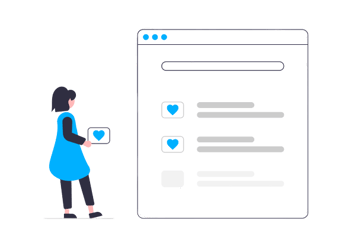What is a Customer Effort Score? (CES)
If you are considering ways to improve your business, taking a look at your Customer Effort Score (CES) is a smart place to start. CES is a service metric designed to measure the effort it takes customers to interact with your business. That can mean anything from how much effort it takes to use a product you sell, to how easy it is to get a problem resolved with your customer service team. Essentially, your CES will show you whether your business is approachable and customer-friendly, or difficult and intimidating.
Finding your CES is as simple as asking your customers about their interactions with you. They can rank their experience in terms of ease and satisfaction and you can figure out if any changes need to be made as a result.
- A low CES score indicates low effort was required to solve the problem.
- A CES can refer to specific aspects of your customer experience, or the overall interaction.
- CES surveys usually ask only one or two questions.
- You can collate information from multiple scores to understand the overall experience of your customers.
- Every question needs to have a measurable metric for the customer to rank their experience on. For example, a scale of 1-5.
If you’re stuck on how to measure your CES, try this CES calculator developed by HubSpot.
Suggestions for CES questions
As long as your CES questions are measurable, straightforward and relevant you can expect answers that get to the core of your business's customer experience. To get you started with CES, here are some examples of topics you can ask about and why they’re important.
CES questions can ask how easy it was to:
- Get help with resolving an issue.
- Find the answer to a question.
- Communicate with the business.
- Make a purchase.
- Use the product or service.
- Use the website.
- Use the website on mobile.
This list consists of the most crucial steps in the customer journey, and pinpointing any issues is well worth the time and effort. Whether it be highlighting any website issues or problems with your customer service system, you’ll find it much easier to keep up with if you’re asking your customers about it directly. This way, all the red flags can be raised before they’ve even become red flags, and the problem can be resolved quickly.
Also, your customers will be more likely to repeat purchases with you and refer you to other prospects if you demonstrate a customer-first approach. Customers expect companies to anticipate their needs and provide high-quality service so you’ll need to be ready to deliver. Any time a customer is forced to wait unnecessarily or deal with a glitch can lead to them taking their business to a competitor and even deterring other prospective customers from your business. Using a CES will catch all of those potential issues before they’ve gotten out of hand, and before customers can share bad reviews with anyone else.
When to use a Customer Effort Score
CES doesn’t need to be difficult, so we’ve put together a summary to help you stay on top of it. All you need to do is recognise the different phases of your customer’s journey, and where they might have some insights into your processes.
When to use a Customer Effort Score (CES)
- When an interaction leads to a purchase.
- When an interaction leads to a subscription.
- Immediately after a customer interacts with your customer service team.
- To complement UI and UX testing for product teams.
A CES helps you to find any sticking points in your customer experience journey, and improve your processes to eliminate them. If at any point your customers are getting frustrated, lost or feeling ignored they are more likely to take their business elsewhere. To avoid any unnecessary problems, use a CES to ask your existing customers how they found dealing with you and if they have any input for improvements.
Why does your CES matter?
Customers shouldn’t need to go out of their way to interact with a business, and more often than not they will go elsewhere after a bad experience. To ensure your business is as accommodating as possible, you’ll need to check-in with customers directly. A CES gives you the chance to keep up to date with the nitty-gritty details of your business practices, and any challenges your customers have to overcome.
Once you know the customer experience well, you can take steps to optimise it. This can mean anything from designing a new user-friendly website to giving some extra training to your customer-facing staff. Using a CES will take out the need for any guesswork on your part because you’ll know exactly what needs changing and why. This way you won’t need to waste time and resources on customer research or business tools that might not even resolve the problem.
How to get started with CES
Starting with CES might seem daunting, but it doesn’t need to be. Platforms like Review Tui are designed to make the process as convenient as possible. You can collect customer surveys into one centralised location and analyse the results, which puts you in a strong position to improve the customer experience accordingly.
Review Tui uses a simple, natural user interface (UI) which gives respondents the option to rank their experience using a range of answer types:
- Draggable options to rank in priority order.
- A sliding scale, e.g. 1-5 or 1-10.
- Drop down of possible options to choose from.
- Free text.
If you want to perfect your customer’s experience you’ll need to tap into your customer effort score. CES is a quantifiable, useful and applicable metric to understand your customers and their interactions with your business. Once you’ve got an understanding of this, you can refine your processes to make your business as hassle-free as possible for customers to deal with.
You’ll find customer retention and sales will increase when your customer experience is seamless and rewarding, so make CES a regular part of your business processes. Looking to implement a customer feedback strategy and use CES as part of that? Why not start by downloading our free online guide?



